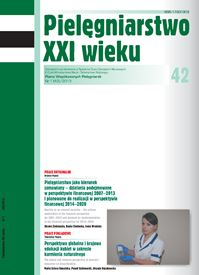Tentative assessment of the awareness of HIV and AIDS-related issues among stu dents of Nursing Faculty
Keywords:
students, nursing, Acquired Immune Deficiency Syndrome - AIDS, HIV, developing health-promoting attitudes, educational role of nursesAbstract
TENTATIVE ASSESSMENT OF THE AWARENESS OF HIV AND AIDS-RELATED ISSUES AMONG STU DENTS OF NURSING FACULTY
Introduction. Nurses play the most important role in the education of HIV -positive and AIDS sufferers since they work directly with patients and their families in the hospital, at their places of residence and also in the work and/or school setting.
Aim. The aim of this study was to assess Nursing students’ awareness of HIV- and AIDS-related issues.
Material and methods. Six –hundred and twenty students of the 1st and 2nd year of the MA programme in Nursing: 94% females, 6% males. Mean age: 37.5 years (SD: 3.27, min. 21, max. 39). All the respondents were employed as nurses. Anonymous voluntaryquestionnaire designed by the authors. The results were presented as descriptive statistics. Subgroups were not compared with regard to any factor and a comparative analysis of the findings is deliberately not included.
Results. Seventy-six per cent report having worked with HIV-infected individuals, while 54% declare that they would rather avoid infected individuals. Sixty-four percent are anxious while performing procedures in HIV-infected patients. Ninety-eight per cent of the students believedthat it is the nurse who should be responsible for educating HIV-positive patients and AIDS sufferers. Twenty-one percent of the students declared that their level of awareness of HIV and AIDS was sufficient to enable them to educate patients.
Conclusions.
- The respondents displayed satisfactory general awareness of HIV/AIDS, but their specific knowledge was definitely insufficient, especially considering that they work as nurses and so should be prepared to educate the public about health promotion issues.
- The students did not consider themselves well prepared to educate others about HIV/AIDS. Study programs for students of nursing should therefore be modified to include specific HIV/AIDS-related content and instruction on how to convey this content, to prepare students to act as educators.
References
1. Ford MT. 100 pytań i odpowiedzi wokół AIDS. Warszawa: Grupa „IMAGE”; 1994:1-7.
2. Cybulska A, Głowaczewska I, Konieczny G i wsp. Najważniejsze pytania o HIV/AIDS - podręcznik dla lekarzy. Poznań: 2007:4-8.
3. Gładysz A. Zakażenia HIV/AIDS podręcznik dla lekarzy praktyków. Wrocław: Wyd. Continuo; 2007:25-40.
4. Halota W, Juszczyk J. Podręcznik dla lekarzy i studentów. Poznań: Wyd. Termedia; 2006:17-28.
5. Gładysz A, Knysz B. Diagnostyka, profilaktyka, klinika i terapia zakażeń HIV/AIDS – współczesne możliwości i problemy. Wrocław: Wyd. Continuo;2009:49-52.
6. Gryciuk E. Fakty na temat HIV i AIDS dla pielęgniarek i położnych. Warszawa: Wyd. Copyright;2000: 33-45.
7. Juszczyk J. Klinika Zespołu Nabytego Upośledzenia Odporności (AIDS). Warszawa: 1990:24-56.
8. Simpkins EP, Sibbery GK, Hutton N. O zakażeniu HIV. Pediatria po dyplomie. 2011; 1: 31-37.
9. Rogowska-Szadkowska D. ABC wiedzy o HIV/AIDS.. Departament Wychowania
i Promocji Obronności, Warszawa: 2010:43-54.
10. Głażewska J. Wiedza studentów na temat HIV. Narkomania. 2011; 1(53): 14-19.
11. Niemiec T. Ciąża i HIV - materiały edukacyjne dla kobiet zakażonych HIV. Warszawa: Wyd. Auxilium; 1998: 45-49.
12. Głażewska J. Jest sobie człowiek..., który nie wie. Warszawa, Kontra – Biuletyn Krajowego Centrum ds. AIDS. 2010; 2 (48):1-2.
13. Rogowska-Szadkowska D. Leki antyretrowirusowe 2002-2003: poradnik dla pacjentów. Warszawa: Wyd. Prószyński i S-ka; 2003: 30-41.
14. Walkowska–Iwańska K. Co musisz wiedzieć o HIV i AIDS. Warszawa: Wyd. Prószyński i S-ka; 2011: 12-38.
15. Rogowska-Szadkowska D. Sposoby zmniejszania ryzyka zakażenia i postępowanie po kontakcie z wirusem HIV. Szczecin: Wyd. Copyright; 1999:52-60.
16. Bieniowski M. Postępowanie diagnostyczne w przypadku zakażenia HIV i zachorowania na AIDS: obowiązujące standardy postępowania dla pracowników medycznych. Warszawa: Wyd. Continuo; 2001:35-39.
17. Marć M, Nagórska M. Pielęgniarstwo a edukacja zdrowotna. T.2. Rzeszów: Wydawnictwo Uniwersytetu Rzeszowskiego; 2010: 56-79.
18. Syrek E, Borzucka-Sitkiewicz K. Edukacja zdrowotna. Warszawa: Wydawnictwa Akademickie i Profesjonalne; 2009:50-59.
19. Czupryna A. VI Konferencja Szkoleniowo-Naukowa z cyklu: Pacjent - Pielęgniarka Partnerzy w Działaniu. Kraków: Wyd. Szpital Uniwersytecki; 2007:34-40
20. Richert-Przygońska M, Surman D, Przygoński F. Co studenci medycyny wiedzą o HIV/AIDS? Wiadomości Akademickie. 2010; 20: 15-16.
21. Markowska A, Jurczak A, Grochans E i wsp. Wiedza pielęgniarek na temat chorób przenoszonych drogą płciową. Pielęgniarstwo XXI wieku. 2010; 1-2 (30-31): 31-35.
22. Van Damme-Ostapowicz K, Krajewska-Kułak E, Olszański R i wsp. Analiza wiedzy studentów pielęgniarstwa w województwie podlaskim na temat chorób zakaźnych i zakażeń szpitalnych. Problemy Higieny i Epidemiologii. 2009; 90 (4):613-620.
Downloads
Published
Issue
Section
License
Copyright (c) 2013 Agata Symon, Joanna Gotlib (Autor)

This work is licensed under a Creative Commons Attribution 4.0 International License.




